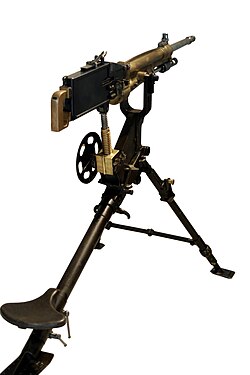St. Étienne M1907
| St. Étienne M1907 | |
|---|---|

|
|
| general information | |
| Country of operation: | France |
| Developer / Manufacturer: | Manufacture d'armes de Saint-Etienne (MAS) |
| Manufacturer country: | France |
| Production time: | 1907 to 1916 |
| Model variants: | Mle 1907, Mle 1907 Transformée 1916 |
| Weapon Category: | Machine gun |
| Furnishing | |
| Overall length: | 1180 mm |
| Weight: (unloaded) | 26 kg |
| Barrel length : | 710 mm |
| Technical specifications | |
| Caliber : | 8 × 50 mm R Lebel |
| Possible magazine fillings : | Loading frame with 24 cartridges each or belts (from 1916) with 300 cartridges |
| Ammunition supply : | Metal loading frame, later also ammunition belts |
| Cadence : | 8-500 (theoretical) rounds / min |
| Number of trains : | 4th |
| Twist : | right |
| Charging principle: | Gas pressure charger |
| Lists on the subject | |
The St. Étienne M1907 ( French : Mitrailleuse Saint-Étienne modèle 1907 ) is an air-cooled machine gun made in France that was used in World War I and World War II .
history
At the turn of the century, the French military examined some MG developments from the private company Hotchkiss et Cie . While the test specimens were technically convincing and some were also purchased, it had been decided for political reasons that the main armament had to come from state-owned companies. A first attempt was the newly developed MG Puteaux M1905 , which turned out to be unsuitable. The design was then revised in the state arsenal of Saint-Étienne , but this did not lead to any significant improvement. In the trench warfare during the First World War , the deficiencies of the St. Etienne came to light, constant jams made the weapon unacceptable for the soldiers at the front. From 1917 the St. Étienne M1907 was finally withdrawn from the front and replaced by the simpler and much more robust Hotchkiss MG. This came into play in its revised model variant Hotchkiss M1914 and was determined to be the standard MG. Remnants of the M1907 were passed on to secondary troops, protection troops in French colonies or to Italy.
technology
Like the Hotchkiss competitor, the St. Étienne is a gas pressure charger . The gas piston with a rack attached to the rear is pushed forward, however, the power transmission to the breech is laboriously via a gear, the closing spring is largely open under the barrel. The firing rate of the weapon can be adjusted between 500 and 8 rounds / min with a hydraulic delay device adopted from the Puteaux predecessor. be regulated.
This device made the weapon, which was already sensitive to contamination and unreliable, additionally complicated. The inferior material added to these problems. The steel used was not heat resistant enough; if the continuous fire continued , either the locking parts tended to break or the closing spring would weaken. The MG was loaded by loading frames that were fed in from the side, which were easily bent and were an additional weak point. A total of 41,000 examples of this weapon were made (30,000 in St.-Étienne and 11,000 in Châtellerault ).
swell
- Ian Hogg : Military Small Arms of the 20th Century . Arms & Armor Press, 1982, ISBN 0-910676-87-9 .
- VISOR special / 45
- George M. Chinn, The Machine Gun, Bureau of Ordnance, 1951 Dept. of the Navy, Washington 25 DC, USA
